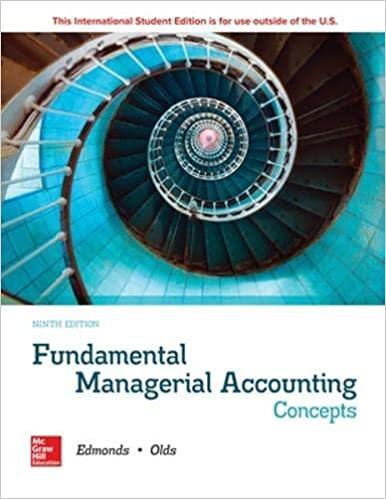Question
5. Estimating and Recording Bad Debt Estimates and Write-Offs; Reporting of Accounts Receivable At December 31, its annual year-end, the accounts of Sun Systems Inc.
5. Estimating and Recording Bad Debt Estimates and Write-Offs; Reporting of Accounts Receivable
At December 31, its annual year-end, the accounts of Sun Systems Inc. show the following.
1. $432,000 in sales revenue for the year, of which one-sixth was on account. 2. $2,160 credit balance in Allowance for Doubtful Accounts, as of December 31 of the prior year. 3. $43,320 debit balance in Accounts Receivable as of December 31 of the current year (prior to any write-offs of uncollectible accounts during the current year). 4. $2,520 in uncollectible accounts to be written off as of December 31 of the current year. 5. Aging schedule at December 31 of the current year, showing the following breakdown of total accounts receivable excluding amounts to be written off.
| Status | Amount |
|---|---|
| Not past due | Remainder |
| Past due 160 days | $9,600 |
| Past due over 60 days | 7,200 |
Required
a. Prepare the entry to write off the uncollectible accounts.
b. Prepare the adjusting entry on December 31 to record bad debt expense for each of the following separate assumptions concerning expected bad debt loss rates. Note: Treat each situation separately.
1. Bad debt expense is based on 1.5% of credit sales. 2. Allowance for doubtful accounts is based on 2.5% of total receivables at year-end. 3. Allowance for doubtful accounts is based on the following aging schedule: Not past due, 0.5%; Past due 160 days, 1%; and Past due over 60 days, 8%. 4. Bad debt expense is based on the direct write-off method (assume entry in part a has not been recorded).
c. Prepare the balance sheet disclosure showing accounts receivable less the allowance for doubtful accounts for each assumption 1 through 4 of part b. For assumption 4 only, assume there is a zero balance in the allowance for doubtful accounts on December 31 of the prior year.
d. For reporting purposes in looking at part b, what is one limitation when using assumption 1 and when using assumption 4?
Note: Do not use negative signs with any of your answers.
| Date | Account Name | Dr. | Cr. | |
|---|---|---|---|---|
| a. | Dec. 31 | CashAccounts ReceivableAllowance for Doubtful AccountsInterest ReceivableInventoryInventoryEstimated ReturnsRefund LiabilitySales RevenueSales ReturnsSales DiscountSales Discount ForfeitedCost of Goods SoldBad Debt ExpenseN/A | ||
| CashAccounts ReceivableAllowance for Doubtful AccountsInterest ReceivableInventoryInventoryEstimated ReturnsRefund LiabilitySales RevenueSales ReturnsSales DiscountSales Discount ForfeitedCost of Goods SoldBad Debt ExpenseN/A | ||||
| To write off uncollectible accounts. | ||||
| b. (1) | Dec. 31 | CashAccounts ReceivableAllowance for Doubtful AccountsInterest ReceivableInventoryInventoryEstimated ReturnsRefund LiabilitySales RevenueSales ReturnsSales DiscountSales Discount ForfeitedCost of Goods SoldBad Debt ExpenseN/A | ||
| CashAccounts ReceivableAllowance for Doubtful AccountsInterest ReceivableInventoryInventoryEstimated ReturnsRefund LiabilitySales RevenueSales ReturnsSales DiscountSales Discount ForfeitedCost of Goods SoldBad Debt ExpenseN/A | ||||
| To record bad debt expense. | ||||
| b. (2) | Dec. 31 | CashAccounts ReceivableAllowance for Doubtful AccountsInterest ReceivableInventoryInventoryEstimated ReturnsRefund LiabilitySales RevenueSales ReturnsSales DiscountSales Discount ForfeitedCost of Goods SoldBad Debt ExpenseN/A | ||
| CashAccounts ReceivableAllowance for Doubtful AccountsInterest ReceivableInventoryInventoryEstimated ReturnsRefund LiabilitySales RevenueSales ReturnsSales DiscountSales Discount ForfeitedCost of Goods SoldBad Debt ExpenseN/A | ||||
| To record bad debt expense. | ||||
| b. (3) | Dec. 31 | CashAccounts ReceivableAllowance for Doubtful AccountsInterest ReceivableInventoryInventoryEstimated ReturnsRefund LiabilitySales RevenueSales ReturnsSales DiscountSales Discount ForfeitedCost of Goods SoldBad Debt ExpenseN/A | ||
| CashAccounts ReceivableAllowance for Doubtful AccountsInterest ReceivableInventoryInventoryEstimated ReturnsRefund LiabilitySales RevenueSales ReturnsSales DiscountSales Discount ForfeitedCost of Goods SoldBad Debt ExpenseN/A | ||||
| To record bad debt expense. | ||||
| b. (4) | Dec. 31 | CashAccounts ReceivableAllowance for Doubtful AccountsInterest ReceivableInventoryInventoryEstimated ReturnsRefund LiabilitySales RevenueSales ReturnsSales DiscountSales Discount ForfeitedCost of Goods SoldBad Debt ExpenseN/A | ||
| CashAccounts ReceivableAllowance for Doubtful AccountsInterest ReceivableInventoryInventoryEstimated ReturnsRefund LiabilitySales RevenueSales ReturnsSales DiscountSales Discount ForfeitedCost of Goods SoldBad Debt ExpenseN/A | ||||
| To record bad debt expense. |
| c. | Balance Sheet, December 31 | 1 | 2 | 3 | 4 | ||
|---|---|---|---|---|---|---|---|
| Accounts receivable | |||||||
| Less: Allowance for doubtful accounts | |||||||
| Accounts receivable, net |
d. Limitation of Assumption 1 AnswerOnly use if results approximate Method 2 or 3.Only use when receivables are 10% of total assets.Ony use in a company's first year of operations.Rarely acceptable under GAAP. Limitation of Assumption 4 AnswerOnly use if results approximate Method 2 or 3.Only use when receivables are 10% of total assets.Ony use in a company's first year of operations.Rarely acceptable under GAAP.
Step by Step Solution
There are 3 Steps involved in it
Step: 1

Get Instant Access to Expert-Tailored Solutions
See step-by-step solutions with expert insights and AI powered tools for academic success
Step: 2

Step: 3

Ace Your Homework with AI
Get the answers you need in no time with our AI-driven, step-by-step assistance
Get Started


